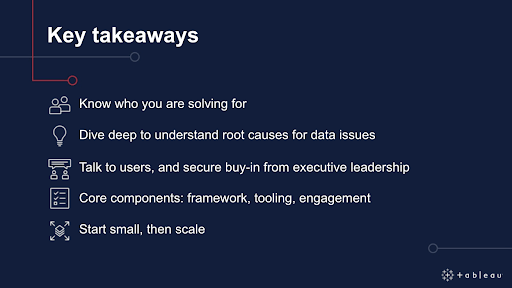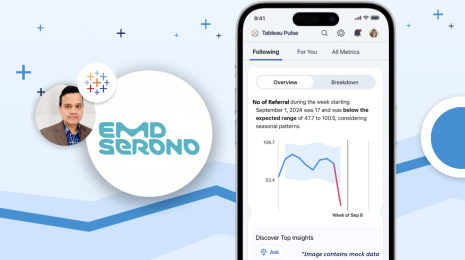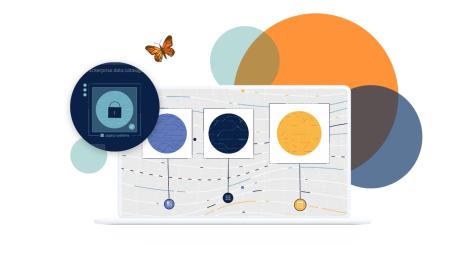How to: Focus on three areas for a holistic data governance approach for self-service analytics
Editor’s note: This article originally appeared on CIO.com.
If we asked you, “What does your organization need to help more employees be data-driven?” where would “better data governance” land on your list? Hopefully, at the top, because it’s the very foundation of self-service analytics. We’re all trying to use more data to make decisions, but constantly face roadblocks and trust issues related to data governance.
Addressing data governance problems can feel like playing Whac-A-Mole—you solve for one data problem, and predictably another pops up. Even within Tableau, an organization focused on analytics, we have our fair share of governance problems—and they’re not unlike what our customers can experience every day.
With a holistic approach to data governance, you can get to the root of common problems, rather than chasing one-off issues. We’ll share how we’re doing this internally at Tableau, focusing on three key areas of understanding and action
- A data governance framework
- Tooling
- Education and engagement
Identify root causes of data governance to drive impactful change
Before diving into your governance framework, it’s important to assess your organization’s needs with a little discovery work. This will set you up to solve the big problems with the greatest impact for most employees. Use these three questions to align:
- Who are you solving for? It’s critical to understand your various stakeholders, across the spectrum of experts to everyday users. At Tableau, we wanted to understand use cases and common issues from our most advanced data scientists to general data consumers.
- What are the biggest and most common problems facing your stakeholders? These problems vary across different groups, but can shed light on shared root causes. For example, Tableau data engineers want a single source of truth to help avoid creating inconsistencies in data sets, while line-of-business users are concerned with how to access the latest data for trusted analysis when they need it most. These audiences share the pain of lacking a single source of truth.
- What are the underlying root causes of these problems? Look for patterns, because it’s likely that 20% of your root problems are causing about 80% of organizational pain. At Tableau, the biggest problems we identified included:
- Unclear ownership and accountability of data: If a businessperson finds a discrepancy or has a question about the data during analysis, the individual often doesn't know who to turn to for data clarity.
- Low data discoverability: For example, Sales doesn’t know what data Marketing even has available, or vice versa—or the team simply can’t find the data when they need it.
- Unclear change management process: There’s little or no formality around what happens when a data source changes. How should this be documented and communicated?
- No single source of truth: There may be multiple versions or variations of similar data sets, but which is the trustworthy data set users should default to?
- Missing data definitions and formulas: People need to understand exactly what the data represents, in the context of the business, to use it effectively.
- Unclear roles and responsibilities: For many data owners, especially if they are embedded in the business, maintaining a data source is not their day job—so they need clarity on exactly what’s expected of them as data owners.
Getting insight from this discovery process will help you uncover root pains and focus your data governance approach. Now let’s look at the components of a holistic approach to data governance: the framework, tooling, and education and engagement.
1. Establish a data governance framework to empower, not restrict, your organization
A governance framework helps you design the picture of what success looks like for your organization by defining the rules and processes that enable self-service with trusted data across the business. Here are the important areas to consider:
Roles and responsibilities: Clarifying roles and responsibilities for data stakeholders helps each person know clear expectations of what to do across the data lifecycle.
Data privacy policy: We all have sensitive data—we need policy and guidelines if and when users access and share sensitive data. This is key to maintaining trust with customers and partners.
- Data quality: Gone are the days of “data is data, and we just need more.” Now, data quality matters. What are your standards across use cases, and how are they met?
- Data certification: Duplicated data can create inconsistency and trust issues. With data certification, your users can understand which is the most trustworthy source for analysis and decision-making.
- Metadata management: Definitions, classifications, and formulas—data about your data—is critical to help employees understand what the data actually means.
- Change management: Your business is constantly evolving. When the structure of your data changes to solve a problem or you want to ensure stakeholder alignment and action, how do you ensure the right communication and documentation to avoid creating 10 additional issues downstream?
- Data maturity model: We need a way to understand where we’re starting from, the north star we are going toward, and how to track our progress.
2. Provide tooling that promotes trust in governed data
The right tooling will help you put your governance framework into practice, providing the necessary guardrails and data visibility that your teams need to boost trust and confidence in their data analysis.
Perhaps the most fundamental tool for data governance—certainly the greatest help for us here at Tableau—is our integrated data catalog. This enables employees to see data details like definitions and formulas, lineage and ownership information, as well as important data quality notifications, from certification status to events, like if a data source refresh failed and the information isn’t up to date.
A data catalog boosts the visibility of valuable metadata right in people’s workstreams, whether that metadata lives in Tableau or is brought in from an external metadata management system via an API. This also helps IT with impact analysis and change management, to understand who and which assets are affected downstream when changes are made to a table.
While not exhaustive, here are additional capabilities to consider as part of your data management and governance solution:
- Data preparation
- Data modeling
- Data migration
- Metadata management
- Security and risk management
- Regulatory compliance
- Data architecture
3. Educate and engage your workforce with your governance strategy
You may be familiar with our mission at Tableau: to help people see and understand data. The key word is people, and enabling people is what this last pillar of data governance is really about. Education and engagement help empower team members to participate fully in self-service analytics. Consider these crucial areas:
- Training: How are people onboarded and trained not only to understand your governance practices, but to feel that they have a stake in them? Training helps to ensure responsible use of data and lasting engagement with your analytics platform.
- Help desk: Providing internal users a first defense to help themselves is a powerful way to scale your analytics program. We created a virtual help desk for when people have questions about how to do data right.
- Data domains and stewardship: We can create frameworks and make tools available all day long, but we’re absolutely not the experts of all the data at Tableau. By establishing data domains, we secure ownership and accountability for data in different pockets of our company. These people then use the framework and tools we provide to start curating and defining their data.
- Data governance council: To drive engagement, we’ve formed a data governance council, which comprises various stakeholders of our data community from across the business, including the heads of customer solutions analytics, finance analytics, people analytics, and data science. In this forum, we hear concerns and needs and make decisions together that will impact our whole organization. It’s important to remember that we’re not investing in data governance just for the sake of it, but to solve real problems for our data community.
With these activities in place, a final consideration would be to think about how your planning and execution can create feedback loops. For example, your data governance council can help inform the targets of your data maturity model beyond just tracking your progress. It’s critical to remember that governance is an ongoing and iterative process, not a destination—and getting input from across the business will help you accurately pinpoint and solve underlying data issues to empower better decision-making with data.
Start small and build on each success to scale your data
Governing data in a self-service analytics environment is not easy—it’s complex, it’s broad, and it’s not something that can be done quickly. It probably will be a long journey with a lot of adjustment and iteration. But, if you follow these tips, you will have a greater chance of success in identifying the right problems to solve and actually make an impact, so everyone in your organization can have a rich experience using data to make business decisions.
Remember, start small. You could zero in on a specific business function or data domain and treat that as a proof of concept. Get a good, quick win, so that you can take any lessons learned, tweak your design and strategy, and then implement a sound data strategy in your organization at a larger scale.
Want to learn more? We presented a deep-dive session on data governance at Tableau during our Virtual IT Summit—we invite you to watch our session on demand.








